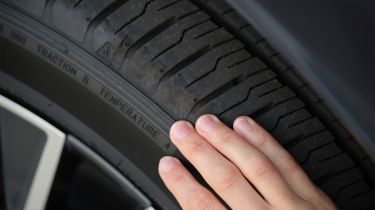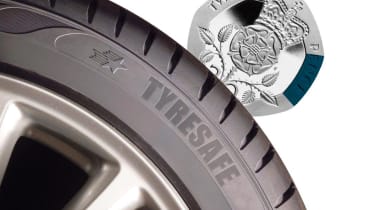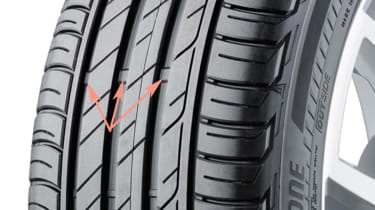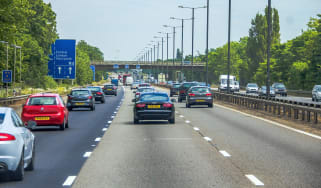Tyre tread depths: minimum legal limit and how to check
It’s important to regularly check your tyre tread depths to make sure they’re safe and legally compliant

Your tyres are vital for the safety of your car, but they can only do their job if they have enough tread depth. Tread depth refers to the depth of the grooves in your tyres – the greater the tread depth, the less worn your tyres are, and the better they can be expected to grip onto the road. Checking your tyre tread depths is an essential part of car ownership, but it’s something that many of us forget to do on a regular basis.
 EU introduces new tyre rules potentially saving consumers £5.9 billion a year
EU introduces new tyre rules potentially saving consumers £5.9 billion a year
Tyre treads are designed to disperse any water from under the tyre while moving, improving grip. Without adequate grip, the safety of your car is dramatically reduced – braking distances will increase, cornering performance will be impacted and your tyres will be more likely to spin. It’s for this reason that your car will fail its MoT test if it doesn’t meet the minimum tread depth requirements. If you’re stopped by the police, you could face a fine of up to £2,500 and three licence penalty points – that’s for each tyre that doesn’t meet the legal requirement.
Tread depth is one thing, but your tyres also won’t perform well if they’re leaking air. Find out how to spot a slow puncture and how to check your tyre pressures.
What’s the UK legal minimum tyre tread depth?
All of your car’s tyres must have at least 1.6mm of tread depth across the central 75% of the tyre to meet the minimum legal requirement.
In other words, if you imagine a line at the centre of the tread in the direction of the car’s travel, the tyre must have at least 1.6mm of tread measured across three quarters of the tyre’s surface from this centre line. This 1.6mm minimum tread depth must be consistent around the whole tyre.
Drivers that are found to be on the road with tyres below the minimum tread depth can receive a fine of up to £2,500 and a maximum of 3 penalty points on their licence per tyre. If all four of your tyres are worn beyond the legal limit, you could face a fine of up to £10,000 and 12 penalty points – enough to disqualify you from driving.
While 1.6mm is the legal minimum requirement, we strongly advise replacing your tyres when the tread depth reaches 3mm. That’s because the amount of grip provided below this threshold reduces drastically.
When a tyre is brand new it will usually have a tread depth of around 8mm. However, winter tyres often carry significantly more.
How to check your tyre tread depths
We recommend giving your tyres a visual inspection every two weeks to check for any glaring issues, such as punctures and cracks. You’ll be able to spot if your tyres are beginning to look worn, but it’s worth taking a proper measurement, too.
You can quickly measure your tyre tread depths using a 20p coin. Take the coin between your finger and thumb and insert the edge in the gaps at multiple points across the tread. A 20mm coin has a rim approximately 3mm deep, so if the tread height doesn’t come up past this mark, it’s an indication that the tyre is very close to requiring replacement.

For a more precise indication of your tyre tread depth, a tread depth gauge can be obtained inexpensively from any good car-accessory store.
Tyre tread wear indicators
Most modern tyres have tread depth wear indicators moulded into the rubber. These take the form of rectangular horizontal ridges in the tread. As the tyre treads wear, the wear indicators get closer to the tyre’s surface. When they become flush with the surface of the tyre, it means the tyre needs immediate replacement.
Although the wear indicators provide a quick visual indication that your tyres are reaching the legal minimum tread depth, it’s still a good idea to have a closer look as regularly as possible.
Why is tyre tread important?
No matter how large your wheels and tyres are, only a tiny amount of each tyre makes direct contact with the road surface at any one time. The ‘contact patch’, as it’s known, is essentially the same size as the palm of your hand, so you want to maximise the amount of grip it has.
With such a tiny amount of material expected to do so much work, it’s important that each tyre can perform at its best. Modern safety systems, such as electronic stability control (ESP) and anti-lock brakes (ABS), help to improve grip with the road, but they can only perform optimally if the tyres have enough grip in the first place. This means it’s vital to make sure that your tyres are in good condition, by checking that their tread depth is sufficient.
If you don’t feel confident about checking your tyres, or would rather not make a judgement for yourself, most tyre shops will happily check the tread depth of your tyres. They’ll also offer an assessment of the condition of your tyres in general.
It’s worth having a good relationship with a local tyre supplier. If you’re familiar with the staff and are likely to choose them to supply your tyres when the time comes, they’ll be only too pleased to check your tyres on request, free of charge.
What does tyre tread do?
Tyre treads are designed to disperse water from underneath the tyre. As a wheel rotates, the grooves in the tyre tread act like a pump, sucking water away from the contact patch. This process effectively dries the road surface so that the rubber on the tyre can grip onto it more effectively. A tyre in good condition can move around 15 litres of water every second.

When your tyre treads are worn down, they can’t perform this process as effectively. If your tyres are struggling to displace the water on the road’s surface, you run the risk of aquaplaning in wet conditions – that means literally skimming on the water trapped between the tyre and the road surface. If this happens, you could be unable to steer or brake, greatly increasing the risk of an accident. Tyres kept in good condition with plenty of tread depth, can prevent this dangerous situation.
Now that you know about tyre tread depths, find out about part-worn tyres…
Recommended

Classic car tax exemption: which historic vehicles qualify?
Most Popular
Tips & advice

Car dashboard warning lights: what does each symbol mean?

Electric car charging stations: public networks, charger types, apps and maps









